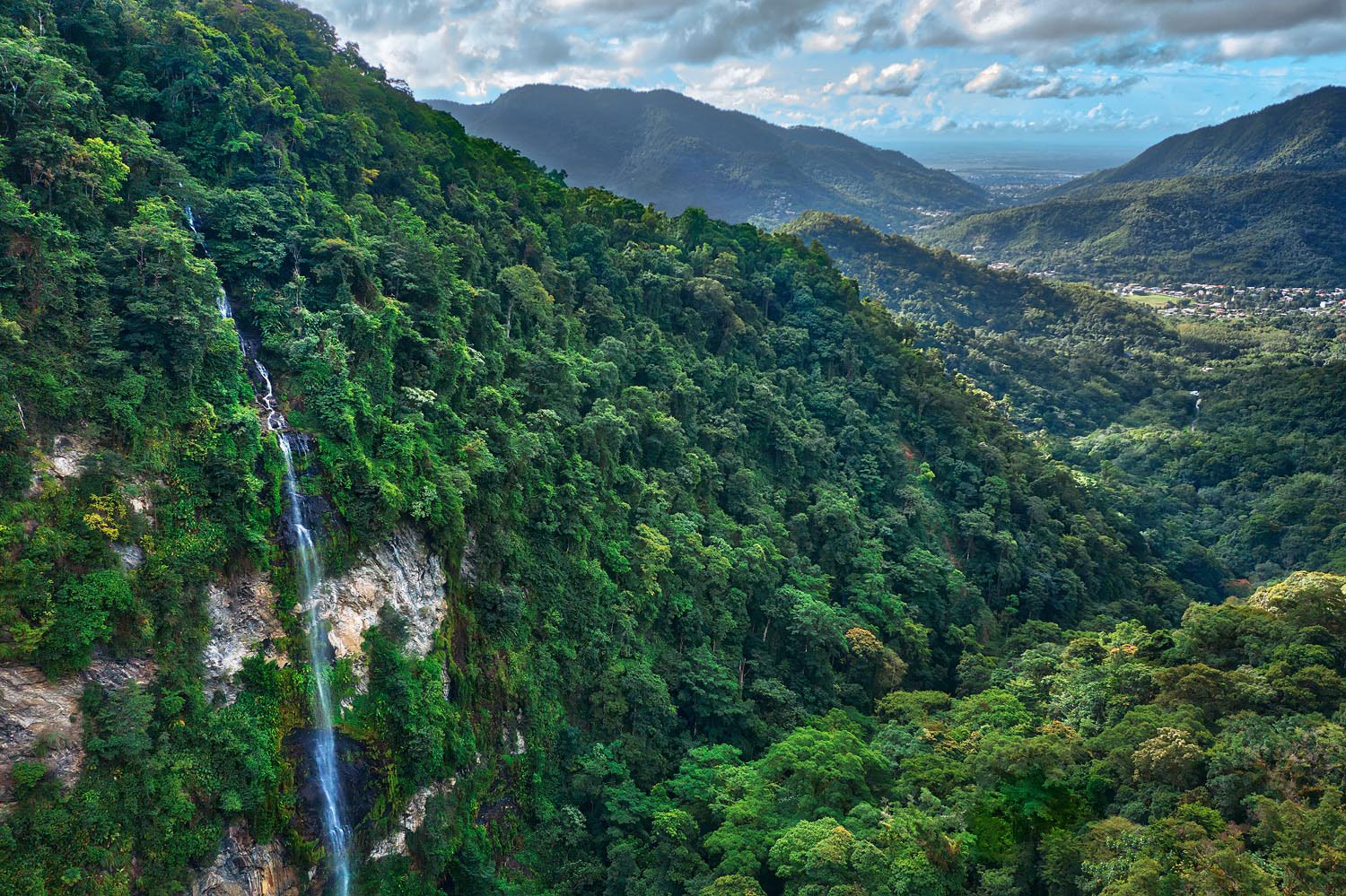Even the busiest and most bustling parts of Trinidad are never far from a touch of the wild — like the forested peaks of the Northern Range, the backdrop to Port of Spain and the urbanised East-West Corridor. Just eight miles east of the capital, Maracas Valley is famed for its three-hundred-foot waterfall cascading down a sheer slope.
On Trinidad’s east coast, Atlantic breakers meet the miles-long beach of Manzanilla Bay. Thousands of coconut trees line the road that heads north to Matura and Toco or south to Mayaro, and just inland are the protected mangroves and flooded palm forests of Nariva Swamp, home to manatees, monkeys, and two species of colourful macaw.
A scuba diver’s paradise, Tobago is surrounded by nutrient-rich seas, reefs teeming with sponges and multicoloured fish, dramatic underwater rock formations and cliffs, and even wrecks awaiting exploration. There are dive sites all around the island, with popular clusters around Speyside on the Atlantic coast, Mt Irvine on the island’s Caribbean side, and Crown Point at Tobago’s southwestern tip.
Port of Spain’s Queen’s Park Savannah — the city’s largest park, a showplace for architectural heritage and annual Carnival celebrations alike — is a green expanse during the rainy season, and a study in gold and pink in the dry season, as numerous poui trees come into bloom.
Trinidad and Tobago are renowned in the birding world for a multiplicity of species — 487 between the two islands — across diverse habitats, from cloud forest to mangrove swamp, from rocky offshore islets to open grassland. Rainforest species like this trogon are found in the heights of Tobago’s Main Ridge and Trinidad’s Northern Range, while the spectacular scarlet ibis shares the lagoons of the Caroni Swamp with flamingoes, herons, and egrets.
Tobago boasts many beaches more remote, rugged, and dramatic, but there’s more than one reason Pigeon Point appears on so many postcards. At the end of another blissful day, what better place to watch the sun set over the warm, glistening sea, setting the horizon ablaze?
Our favourites
Members of the Caribbean Beat team share some of their personal tips and recommendations for a memorable visit to the magazine’s home territory
If you’re looking for a close, green getaway from the noise of Port of Spain, Tucker Valley in Chaguaramas National Park has got you covered. Head to the Bamboo Cathedral and Tracking Station trail for some heart-pumping cardio, incredible scenery, and compelling Cold War history. Afterwards, make sure to pop by Macqueripe Bay for a refreshing dip. On your way out, feel free to stop by the U-Pick farm for a delicious organic lunch and an ambient dining experience in the lush greenery.
Kristine De Abreu
It was the location of my first official birdwatching outing, and it would set the seal on an enduring passion. Hollis Reservoir is the oldest man-made dam in Trinidad, but despite its manufactured origins, it can compete with the most bucolic of beauties. Cradled in the foothills of the Northern Range, it is home to ninety species of bird. There is no end to the bewitching avian colours and diverse cadences of birdcalls that will keep your binoculars glued to your face.
Tracy Farrag
One of my favorite places is Icacos in south Trinidad. It’s literally at the end of the island, and it feels like you’re in a different country. Driving through vast coconut plantations creates the fantasy of a safari: cattle cross the road, quicksand lurks among the mangroves, and scarlet ibis seem to guide you to the beach where fisherfolk are bringing in their catch of the day. The villagers are chatty and they make the best homemade ice-cream I’ve ever tasted in Trinidad, too — soursop, barbadine, coconut, they have it!
Shelly-Ann Inniss
The Queen’s Park Savannah Night Market is my go-to spot when I want to eat out. Located in the area called “The Strip” — just across from the National Academy of Performing Arts — are most varieties of local street food, conveniently in one spot. From doubles and corn soup to fruit punches and ice cream — I’m always certain to find something to satisfy my cravings.
Kevon Webster
Cotton Bay on Tobago’s Leeward Coast is accessible only by boat. You can enjoy the scenic coastline on a visit to this untouched, secluded beach, cooling off with a swim or snorkel in the clear blue water, or lazing on the sand under a towering green mountain. Another of my favourite Tobago beaches is Back Bay — less visited, but easily accessible. I really don’t understand why more people don’t come here, but I’m not complaining, as I love it so. For surfing, if you’re looking for a great point break, Mt Irvine is the place to go. I also love this bay for kayaking and paddleboarding.
Evelyn Chung
One of my favourite things to do in Trinidad (and Tobago, too) is a round-the-island tour. Trinidad is tough to do in a day, unless you start really early and limit your stops. But even if you tackle different sides of the island on different days, it’s worth it, given how much Trinidad’s human and physical geography vary from coast to coast. One of my favourite experiences is to walk out onto the rocky outcrop at Galera Point, at the northeastern tip of the island. To one side crashes the navy blue surf of the Atlantic Ocean; to the other, the gentler turquoise water of the Caribbean Sea. Here the two bodies of water meet, with a distinct demarcation in colour.
Caroline Taylor
























